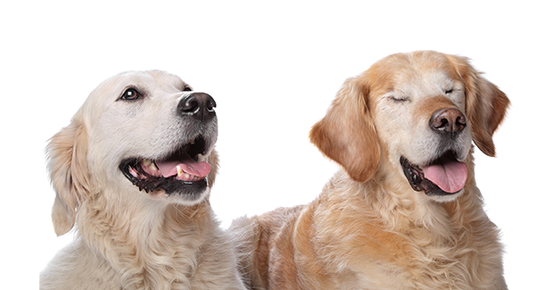
As veterinary medicine advances, dogs are living longer and longer. With advancing age, more geriatric diseases are becoming prevalent. Problems with vision, such as cataracts, glaucoma, and keratitis, are common. Many of these problems occur so gradually that some people don't know they have a blind dog if the dog is very accustomed to the house. But some dogs have trouble adjusting to their disability. There are changes you can do to make their life easier.
If your dog has slight vision, you can use contrast. For instance, if you have a light colored floor, use a dark colored mat and white food and water bowls. Stairs can be made easier to negotiate if you use contrasting colored tape on the edge of the step and the riser. If you have dark carpet or wood, you can use one inch white tape. If you have light colored steps, you can use black electrician's tape on the stairs. You can also use the black tape vertically on the corners of walls at the height of the dog's field of vision in areas where the dog may have difficulty.
For other problem areas, or if you have a totally blind dog, you can use a variety of padding materials. Foam pipe insulation comes in lengths that can be cut to an appropriate size to cover table legs, edges of coffee tables, corners of walls, etc. Other good padding materials are bubble wrap and infant bumper pads. You can use different scents to mark areas. Here you are capitalizing on a dog's amazing smelling ability. Oil based scents last the longest. You can mark areas to be avoided with one scent and use other scents to mark areas they need to use. For instance, you could mark the doggy door with a citrus scent, each step with a rose scent, and areas to be avoided with a pine scent. Apply these scents very sparingly. A dog's olfactory sense is vastly better than ours and you don't want to overwhelm them. You will have to train the dog as to the meaning of these scents.
The best recommendation for furniture arrangement is to not change the location of furniture to which the dog is accustomed. If the dog still has problems you can try to train it to use walkways you create with plastic carpet runners. Dogs don't naturally like these, so you have to train it, usually using treats. Once trained, the runners are great because you can direct the dog to important areas: food bowls, dog beds and the door to the outside. You can even continue the runners outside to a certain area of the yard.1
Norman The Hero Dog
In the summer of 1996 an amazing incident occurred on the Oregon coast. Where the Necanicum River enters the Pacific Ocean, unusual undercurrents are created.
Norman, a yellow Labrador Retriever, was running along the beach with his owner Annette. Unexpectedly, Norman ran into the ocean and started swimming straight into deep water. Annette was frantic. She didn't know what Norman was doing, where he was going, or even, if he could swim! She called his name repeatedly, but he continued to swim away from her.
Annette became aware of something else. What she thought had been the joyful noises of children at play were really cries for help. Lisa, a teenage girl, had been playing in the water with her younger brother, both of whom were capable swimmers. Lisa could no longer manage the deep and swift waters. Her brother was able to swim to shore but Lisa needed help.
Annette realized what was happening. Norman must have recognized the urgent pitch in Lisa's voice, and was swimming to help her. Annette called out to the girl..."HIS NAME IS NORMAN, CALL HIS NAME"! And so she did.
Norman swam to her. She held on to his thick fur as they made their way to shore. Lisa lost her grip. Annette again hollered, "CALL HIS NAME, HIS NAME IS NORMAN". Again, the two caught up with each other and headed to shore.
This would be a wonderful story had it ended right there. What makes it truly touching is that Annette and her husband had adopted Norman from the local animal shelter on the day before he was scheduled to be euthanized. Even more amazing was that Norman had been suffering from Progressive Retinal Atrophy (PRA) for the two years prior to this incident. He was completely blind when he saved Lisa.
When Norman's vision started deteriorating, friends told Annette and her husband to have the dog euthanized. They were so very happy that they didn't. The same was true for Lisa and her family. Blind dogs can live happy and productive lives.2
1,2 Levin, Caroline. Living With Blind Dogs. Lantern Publications,18709 S. Grasle Road, Oregon City, OR 97045 ISBN 0-9672253-0-2.

